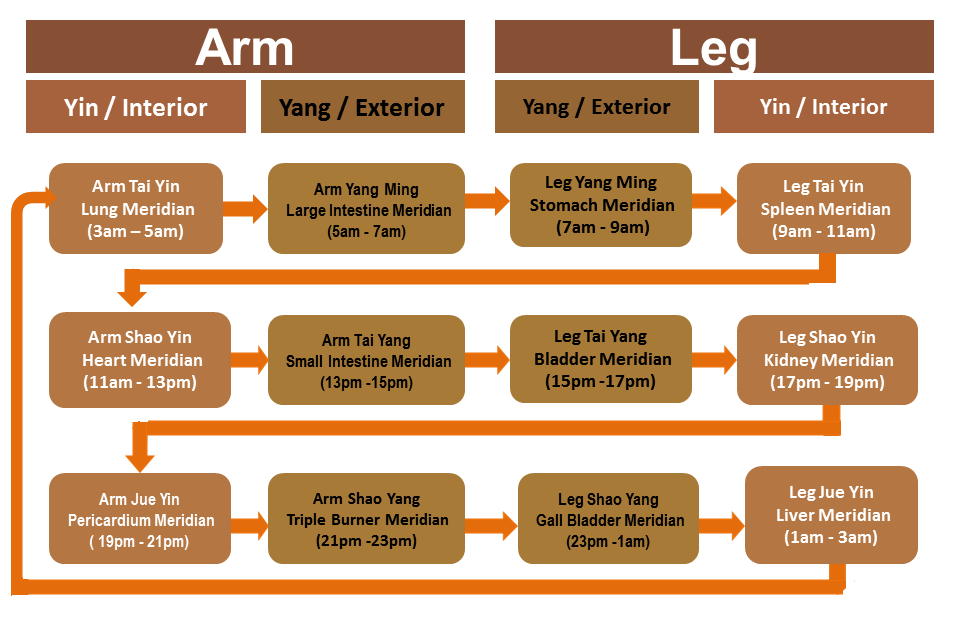Sleep is an innate recurring process of the body and mind, which is an important part of our daily routine. Traditional Chinese Medicine (TCM) views sleep from a holistic approach, that the sleep-wake cycle is as a dynamic yet integral physiological state. Physicians apply unique theories like yin yang, qi circulation and spirit activity to understand and explain the sleeping process.
Internal Rhythm of Body
The rhythm of nature can be interpreted by the
yin yang theory. Yin represents night and static functions, while yang represents day and dynamic functions, rotation of day and night reflects a process of ebb and flow of yin and yang. The human body is programmed to live in harmony with the nature, that closely abides by “working at day, and resting at night.” Thus, the body develops the sleep-wake cycle, and the movements of its
yang qi correspond to the daily rhythm.
As
The Vital Axis states: "When yang qi is at its limit and yin qi becomes abundant, one's eyes are closed. When yin qi is at its limit and yang qi becomes abundant, one is awake." The sleep-wake cycle is mainly dominated by the movements of yang qi inside the body. At dawn, yang qi rises and moves towards outer body, the body wakes up and becomes active; at noon yang qi reaches the peak; at dusk yang qi declines obviously; at night yang qi moves towards inner body and hide, the body needs rest. We naturally go to bed at the yin predominate time (night) while wake up at the yang predominate time (day). Sleep recharges the body, and is important in maintaining the balance of yin and yang within it.
The Internal Qi Cycles
On a daily basis,
qi (vital energy) follows a specific time schedule and pathway to circulate throughout the body. TCM believes that qi is more prevalent in different meridians at different times. For example, physicians use the "Daily Qi Current " as one of their clinical guidelines. The sleep-wake cycle is regulated by the energetic cycle, in particular two types of qi – protective qi and nutritive qi.
1. Circulation of protective qi
Protective qi has a yang property because it has more functional characteristics such as fighting against evil invasions or controlling sweating. This qi mainly flows along the
yang meridians (outer body part) in daytime, while along the yin meridians (inner body part) and through the
five zang organs at nighttime. Protective qi circulates through the body 50 times per day, afterward it will meet nutritive qi to prepare for the next day circulation.
During daytime, protective qi starts from the bladder meridian, passes through the small intestine meridian, gallbladder meridian, triple burner meridian, stomach meridian, and finally reaches the large intestine meridian as one cycle. From dawn to sunset, protective qi repeatedly flows through the yang meridians for 25 times, which enables the body staying active and awake. At nighttime, protective qi enters the yin meridians and circuits through the kidney, heart, lung, liver and spleen respectively for 25 times, which keep the body inactive and sleep.
There are two extra meridians, the Yin Heel and Yang Heel Vessels (see graphics) that help strengthen the communications between the yin and yang meridians, and also govern the opening and closing of the eyes. It is claimed that the acupoint
qing ming (Bl 1), located at inner canthi of the eyes, are where protective qi flows in and out the body.
 |
 |
|
Yin Heel Vessel
|
Yang Heel Vessel |
Since it is the day and night flowing patterns of the protective qi that result in different physiological activities during sleeping and waking up. When disease occurs along the circulatory pathways and affects the qi flowing, there will be sleep problems. Generally, if protective qi is held up in yin, the body will become sleepy; if protective qi is held up in yang, the body will become difficult to sleep. Emotional distress or evil invasion can easily break the qi flowing pattern, affect it entering yin, and so insomnia and difficult to fall asleep will result.
2. Circulation of nutritive qi
Nutritive qi has a yin property as it can form into materials needed by the body. Nutritive qi mainly flows along the regular meridians and continuously circulates through the body in a daily basis. Early in the
Yellow Emperor’s Classic of Internal Medicine had recorded about the flowing pathways:
Lung meridian → large intestine meridian → stomach meridian → spleen meridian → heart meridian → small meridian → bladder meridian → kidney meridian → pericardium meridian → triple burner meridian → gallbladder meridian → liver meridian → Governor Vessel → Conception Vessel. The nutritive qi flows one cycle per day, and will start from the Lung meridian again in next day.
Both nutritive and protective qi share the same origin, but they flow in different places and also in opposite directions. The nutritive qi flows inside the meridians, while protective qi flows outside the meridians. Their movements work in a coordinated yet balanced manner, so as to maintain a smooth sleep-wake cycle.
The Spirit (shen) Activity
The sleep-wake cycle is also part of
spirit activities. Spirit in Chinese medicine refers to thought, state of consciousness and mental functions that keep the mind sharp and alert. It is the highest authority of the physical body that orders it to rest or work. In coordinating with the natural rhythm, the spirit hides in the organs at night for recharging, and comes out during daytime to exert its duties. Sometimes when individuals become too excited, for example during emotional conflict, sleeping problems will be experienced.
In conclusion, normal sleep is resulted from a harmonious internal body; yang governs waking, while yin governs sleeping. When insomnia develops, it is due to yang not interacting with yin, in other words, the internal environment has been disturbed or becomes overly excited, leading to a restless state of the mind.







